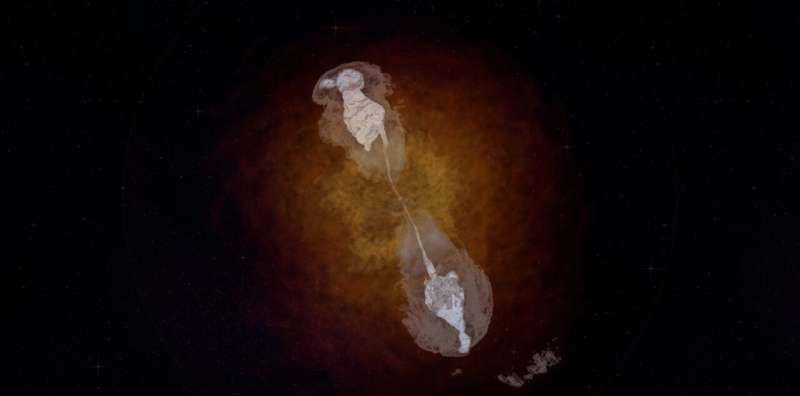This article has been reviewed according to Science X's editorial process and policies. Editors have highlighted the following attributes while ensuring the content's credibility:
fact-checked
peer-reviewed publication
proofread
New astrophysics model sheds light on additional source of long gamma-ray bursts

Cutting-edge computer simulations combined with theoretical calculations are helping astronomers better understand the origin of some of the universe's most energetic and mysterious light shows—gamma-ray bursts, or GRBs. The new unified model confirms that some long-lasting GRBs are created in the aftermath of cosmic mergers that spawn an infant black hole surrounded by a giant disk of natal material.
Astronomers previously thought that black holes that generate long GRBs typically form when massive stars collapse. However, the new model shows that they can also arise when two dense objects merge, such as a pair of neutron stars—the dense, dead remnants of massive stars—or a black hole and a neutron star. The findings explain recently observed long GRBs that astronomers couldn't link to collapsing stars.
The simulation's creators present their results in The Astrophysical Journal Letters.
"Our findings, which connect observations with underlying physics, have unified many unresolved mysteries in the field of gamma-ray bursts," says Ore Gottlieb, lead author on the new study and a research fellow at the Flatiron Institute's Center for Computational Astrophysics (CCA) in New York City. "For the first time, we can look at GRB observations and know what happened before the black hole formed."
GRBs are some of the brightest and most violent events in the cosmos. Since their first detection in 1967, GRBs have dazzled and puzzled astronomers. Even decades later, the exact mechanisms that generate the mighty blasts of gamma rays remain uncertain. Over the years, astronomers have noticed two distinct populations of GRBs—ones lasting less than a second and others that linger for 10 seconds or more.
Researchers eventually determined that short GRBs originate from jets launched after the merger of two compact objects and that long GRBs can occur when jets are launched during the collapse of massive rotating stars. But in the past year, two unusually long GRB observations suggested that collapsing behemoths weren't the only things causing long GRBs.
Gottlieb and his colleagues ran state-of-the-art simulations to test how mergers of massive compact objects can spark GRBs. The new simulations took months to run and were partly conducted on one of the Flatiron Institute's supercomputers. The new simulations start when the two compact objects are in a close orbit and follow the jets until they are far from the merger site. This approach allows the researchers to make fewer assumptions about the physics involved.
By combining the simulations with constraints from astronomical data, the scientists constructed a unified model for the GRB origins.
The researchers determined that the unusual GRBs are generated after a merger between two compact objects. After merging, the objects create a black hole surrounded by a large accretion disk—a rapidly rotating doughnut of magnetically charged leftover material—that can pump out long GRBs. This information from the simulation helps astronomers understand not only the objects creating these GRBs but also what came before them.
"If we see a long GRB like the ones observed in 2022, we now know that it's coming from a black hole with a massive disk," Gottlieb says. "And knowing there is a massive disk, we now can figure out the ratio of the masses of the two parental objects because their mass ratio is related to the properties of the disk. For example, the merger of unequal-mass neutron stars will inevitably produce a long-duration GRB."
The scientists hope to use the unified model to identify what objects create short GRBs. Those bursts, the model suggests, could be caused by black holes with smaller accretion disks, or they might come from an object called a hypermassive neutron star, which is an unstable form of the star that quickly collapses to form a black hole but not before it pulses out short GRBs.
The scientists hope that with more observations of GRBs, they can further refine their simulation to determine all GRB origins. Though GRB sightings remain relatively rare, astronomers aim to capture many more when the Vera C. Rubin Observatory starts observing in early 2025.
"As we get more observations of GRBs at different pulse durations, we'll be better able to probe the central engines powering these extreme events," Gottlieb says.
More information: A Unified Picture of Short and Long Gamma-ray Bursts from Compact Binary Mergers, The Astrophysical Journal Letters (2023). DOI: 10.3847/2041-8213/ad096e
Journal information: Astrophysical Journal Letters
Provided by Simons Foundation




















